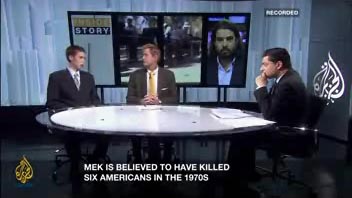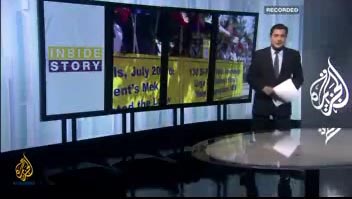We examine why the US has decided to de-list the Iranian group Mujahedin-e-Khalq as a terrorist organisation.
The US has designated the Iranian group Mujahedin-e-Khalq (MEK) as a terrorist organisation since it began keeping a terrorist list in 1997.
The group’s supporters say it represents Iran’s democratic opposition, and is working for a nuclear-free Iran. But critics argue it has a violent history that dates back to the reign of Shah Reza Pahlavi.
“What may have happened in the past few months is the US essentially cut the best deal to relieve this headache of having the MEK in Iraq, that is to get the members out of Camp Ashraf and into Camp Liberty, and as many of them as possible resettled into third countries.”
– Ali Gharib, a senior editor of Open Zion blog
The group was sheltered by Saddam Hussein, Iraq’s former leader, as it carried out attacks against Iran during the Iran-Iraq war.
In fact, as the US made its case for invading Iraq in 2003, it cited the Iraqi leader’s support for the MEK as evidence of his support for terrorism.
But now, after a two-year lobbying campaign that enlisted many prominent US politicians and former military officers, the group will no longer be considered a terrorist organisation.
Former US officials have received tens of thousands of dollars to give speeches to and on behalf of the MEK.
Millions of dollars have been spent on a campaign to get the MEK dropped from the banned list of terror groups.
Three top Washington lobby firms have been paid a total of nearly $1.5m over the past year to press the US administration and legislators to support the de-listing if the group.
The US treasury department is believed to be investigating whether speaking fees paid to MEK supporters are restricted by a law that prohibits Americans from doing business with designated terrorist groups.
Ed Rendell, the former Democratic governor of Pennsylvania, has accepted more than $150,000 in speaking fees at events in support of the MEK’s unbanning.

Tom Ridge, who served as secretary of homeland security under George Bush, has also received speaking fees.
“They certainly appeared on the list at a time which was politically very convenient for the US government which was trying to reach out to Iranian government … it was the Iranian government that brought to their [US] attention that the MEK was not on the list.”
– Patrick Clawson, the research director at the Washington Institute
Ileana Ros-Lehtinen, the Republican chair of the House of Representatives foreign affairs committee, has accepted at least $20,000 and has spoken out against the ban.
Other prominent American politicians who have spoken in favour of the MEK include Democratic governors and former presidential candidates Howard Dean and Bill Richardson. Another Democratic support is NATO commander Wesley Clark.
And Republican Rudolph Giuliani, the former New York mayor, has also called for the ban to be dropped.
In addition to the MEK, the US state department lists 52 foreign terrorist organisations including al-Qaeda, Hamas, Islamic Jihad, Hezbollah, as well as the Real IRA and the Continuity IRA.
So what is the MEK and why is it being removed from the US terrorist list now? Has the group really changed?
Joining Inside Story Americas for the discussion with presenter Shihab Rattansi are guests: Ali Gharib, a senior editor for the Daily Beast’s blog, Open Zion; Patrick Clawson, the director of research at the Washington Institute for Near East Policy; and Jeremiah Goulka, the lead author of The Mujahedin-e-Khalq in Iraq: A Policy Conundrum, and a former justice department lawyer.
“After the Iran-Iraq war the leaders of the MEK Massoud and Maryam Rajavi turned the group into a cult, partly because they were unable to get new recruits from Iran … the move to join Saddam Hussein ended any legitimacy that the MEK had among the Iranians.”
Jeremiah Goulka, a former US government lawyer
——————————————————————————–
WHO IS THE MEK?
•Founded in 1965 by Islamic-Marxist students, the group helped to overthrow the Iranian government in 1979, prompting a clampdown following the revolution
•The group began an armed struggle against the US-backed Shah of Iran in 1971
•Saddam Hussein, the former Iraqi leader, used them for attacks against Iran and the Kurds
•In 1981, the group launched a bombing campaign attacking the Islamic Party headquarters, killing Iran’s president and the prime minister
•The US disarmed them following the 2003 invasion of Iraq, which the MEK agreed to in exchange for protection.
•The US turned over MEK refugees to the Iraqi government in 2011
•Massoud Rajavi led the group since 1972 but has not been seen since 2003. His wife Maryam Rajavi is the group’s public face now
•Many members are refugees in both Iraq and France, and the group’s leaders continue to live and operate in France
902
Inside Story Americas,Aljazeera.com

